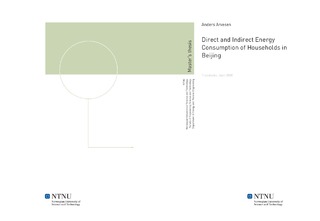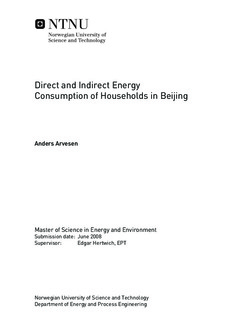| dc.description.abstract | China's economy has grown at remarkable rates in the last three decades, bringing about big improvements in people's quality of life. On the downside, the increased economic activity has contributed to serious environmental problems, many of which are related to the country's energy system. Focusing particularly on Beijing, this study aims at illuminating how income growth and lifestyle changes relate to energy use in the society. An extended input-output analysis is applied to estimate the direct and indirect household energy consumption (HEC) of Beijing households at different levels of development in the year 2005. Using observations of how HEC varies across income groups in 2005 as a basis, projections of HEC towards 2015 are made. According to the results, the total HEC in Beijing amounts to 42% of the total direct energy use occurring in all sectors within Beijing's geographical boundaries. Hence, a significant portion of the energy use in the society can be linked with consumer activities. For urban residents, indirect influences on energy use are found to be more than three times greater than the direct influences. Mainly due to growing incomes, total HEC in urban Beijing will grow substantially in the period 2005-2015, even with overall efficiency improvements corresponding to the central government's targets. The results indicate that the share of transport related energy use to total HEC will increase significantly. Without major efficiency improvements, huge increases in transport related energy use is to be expected towards 2015. Air conditioners will be the most important single electrical appliance contributing to increased residential electricity consumption in the near future.Due to significant uncertainty, the figures should be taken as rough guides to the magnitude of different types of energy use only. Nonetheless, it is the author's opinion that the study produces valuable insights that can add to our understanding of the underlying drivers of energy use in the Beijing society. The estimates are considered sufficiently accurate to serve as a basis for making some recommendations for improving the energy efficiency of the society. Based on the findings of the study, the author calls on central and local governments to: 1) Further incorporate the important role of consumer behaviour and lifestyle into energy conservation policies; 2) Make strong efforts to mitigate transport related environmental problems, focusing attention both on producers and consumers; 3) Give high priority to constructing energy efficient buildings; 4) Further strengthen and expand the performance standard and labelling scheme for electrical appliances; 5) Consider imposing constraints on the promotion of consumerism by the mass media and advertising industry. | nb_NO |

